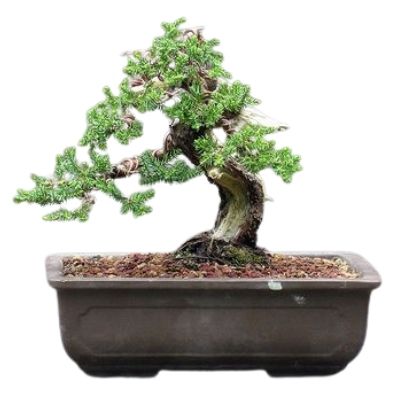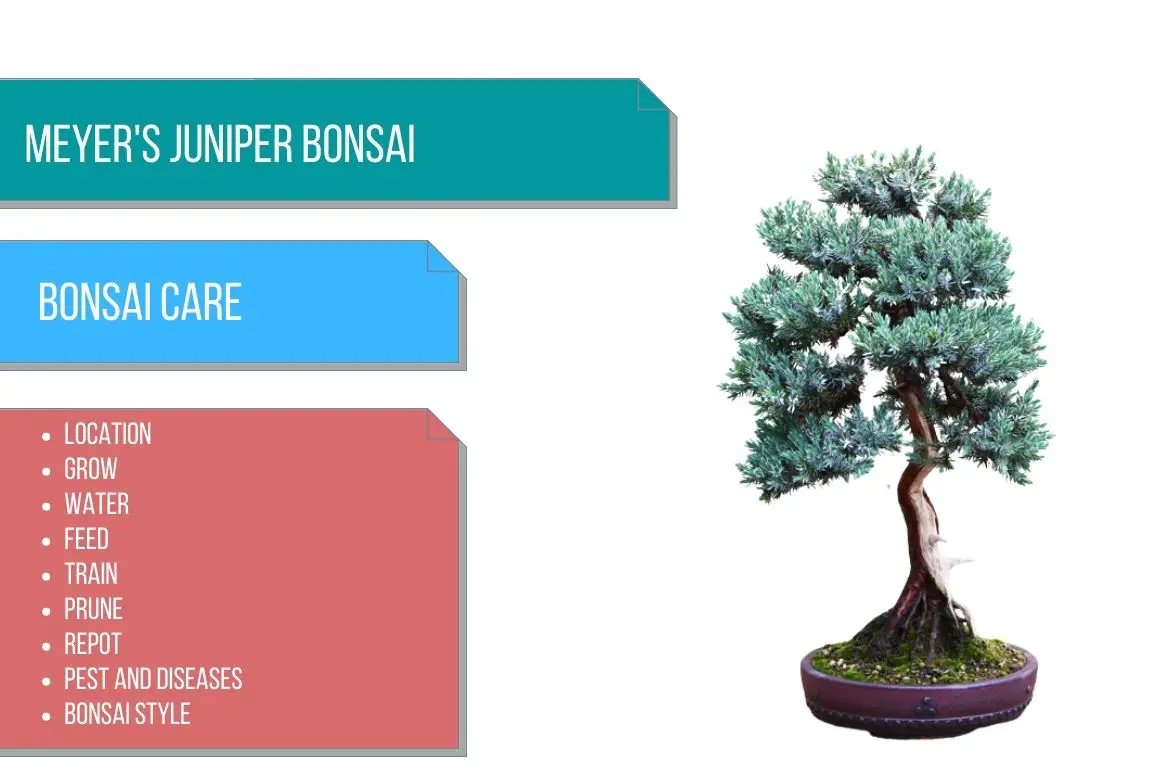
Meyer’s Juniper
(Juniperus Squamata ‘Meyeri’)
Country of Origin : Nepal and China
Bonsai Styles : Informal upright, cascade, group
Zone : 4 – 9
Meyer Juniper also known as ‘blue juniper‘ or ‘singleseed juniper‘ is an evergreen conifer.
Several varieties of Juniperus Squamata bonsai tree have become immensely popular. A variety of this type, Juniperus Squamata ‘Meyeri’ bonsai tree, has also become one of the most popular bonsai subjects in the West.
Meyer juniper bonsai tree is similar to Chinese juniper bonsai tree is all aspects, except the foliage color. Juniperus Squamata bonsai tree has bluish-silver foliage.
Meyer’s Juniper bonsai tree has aesthetically pleasing bark, compact growth and flexible branches.
Soft blue needles cover the slender, floppy young shoots densely, almost hugging them as they reach forward. When the shoot reaches its full extent, the needles stand more upright, revealing the tiny buds dormant at the base.
Best location to keep Meyer’s Juniper Bonsai
The foliage of Junipers grows neatly and compactly under full sun.
Juniperus Squamata bonsai tree also does well in semi shade. In partial shade, the color of the foliage will be richer. However, in shade, the growth of the bonsai tree is slow in spring.
Shade will also protect the bonsai tree from extreme cold and hot temperature variations.
In all temperate regions of Europe, the Meyer’s juniper bonsai tree does not require special protection in winter.
However, they should not be considered hardy in North America. It is advisable to move plants into a frost-free shed during winter when temperatures drop below 14°F (-10°C).
Refer sunlight requirements for indoor plants for more indoor plant placement ideas.
Propagation of Meyer’s Juniper
Meyer’s juniper tree can be propagated by using stem cuttings.
Watering Meyer’s Juniper Bonsai
In spite of being drought-tolerant, junipers can soak up large amounts of water.
During the growing season, water the Blue juniper bonsai tree well.
In spring and early summer, you should water your bonsai once a day; by midsummer, you should water twice a day.
Water once a day towards the end of summer and into fall.
It is best to keep the soil just moist in winter.
Do not allow the soil to become waterlogged and do not let it completely dry out.
Wiring Meyer’s Juniper Bonsai
This bonsai tree can be wired in between early spring and fall.
Make sure that you do not catch any foliage under the wire.
The wires should not be left on the Meyer’s juniper bonsai tree for more than one year.
Pruning Meyer’s Juniper Bonsai
When to prune Meyer’s Juniper bonsai?
How to prune Meyer’s Juniper bonsai?
Juniperus Squamata bonsai tree naturally has a very compact growth pattern.
Usually the basic branch structure is achieved in the bonsai nursery (from where you will buy the bonsai tree specimen).
Therefore, the primary pruning task is confined to just pruning the older shoots so that the newer shoots have some space to emerge.
Young shoots should not be allowed to grow longer than necessary.
Late summer is a good time to prune the old shoots and branches. Because late summer is the time when the sap content of the tree is not typically rising, hence reducing the chances of ‘bleeding’ of the tree while pruning.
Pinching Meyer’s Juniper Bonsai
Pinching can be done from early spring to fall to hold the intended style of the blue juniper bonsai tree.
If new shoots break the silhouette of the foliage cloud, you can pinch them back with your fingers.
It’s okay if you pull away an entire shot every now and then. They’ll be replaced by new shoots soon enough.
As the shoots are quite floppy, many of them grow downward from the underside of the branches. If the shoots are young, pull them out. For older underside shoots, cut them at the base of the branch. This will keep the underside of the branches clean.
Repotting Meyer’s Juniper Bonsai
When to repot Meyer’s Juniper bonsai?
Repotting of Juniperus Squamata bonsai tree can be done in early to mid spring.
Repot every 2 years. However, when the tree becomes 10 years old, you can repot the Juniperus Squamata bonsai tree every 5 years or so.
If the roots still have room to expand in the bonsai pot, do not repot the tree.
When repotting, do not prune more than 1/3 of the roots.
You can use a free draining bonsai soil mix.
OR
You can also use a bonsai potting soil mix with 60% grit and 40% organic matter.
Must Read: Bonsai Soil Recipes
Must read : Choosing the right bonsai container
Feeding Meyer’s Juniper Bonsai
Throughout the growing season, use a balanced feed. Add nitrogen-free feed to the soil in the fall season.
Diseases and pest of Meyer’s Juniper Bonsai
As with all the other juniper bonsai trees, spider mites, scaled insects and caterpillars can pose some problems. Most of the damage is caused by spider mites.
Foliage that is congested may become infected with fungi. Fungicides can be applied systemically.
It is generally possible to remove aphids and scale insects with a jet of water, however if an infestation is severe apply a systemic insecticide.
Meyer’s Juniper bonsai care
Meyer’s juniper, like most junipers, will produce adventitious shoots from the intersections of branches and from the places where the branches meet the trunk.
It is recommended that you prune these shoots as soon as they appear. However, in case you are planning to make new foliage clouds by generating new branches, you can avoid pruning these shoots.
In young trees, the shoots are loosely attached to the branches, which makes them easy to knock off when wiring or pruning carelessly.
Eventually, they will regenerate, but it would be best to avoid dislodging them.
What to look for when buying Meyer’s Juniper Bonsai
Meyer’s juniper bonsai are rarely imported from the East. Western nurseries frequently produce Meyer’s junipers bonsai trees.
However, often homegrown Juniperus Squamata bonsai tree may not possess the elegance of an imported Meyer’s juniper bonsai tree.
When buying the bonsai specimen, try to pick a specimen which is a little less developed. So that you have more freedom in designing the bonsai style.
Look for a tree which has series of curves. These curves should not have any acute and sharp bends. Sharp turns in the trunk does not look natural in Meyer’s juniper bonsai tree.


1 comment
I’m truly enjoying the design and layout of your site. It’s a very easy on the eyes which makes it much more enjoyable for me to come here and visit more often. Did you hire out a designer to create your theme? Fantastic work!